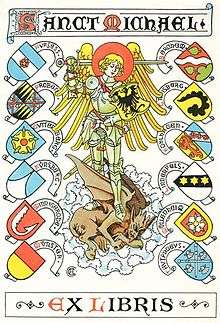Gustav Adolf Closs
Gustav Adolf Carl Closs (6 May 1864, Stuttgart - 3 September 1938, Berlin) was a German painter, illustrator and heraldist.
Biography
His father was the woodcut artist, Adolf Closs (1840-1894). His father's twin brother was the landscape painter, Gustav Paul Closs. He began his education in the public schools of Stuttgart; graduating in 1882. He then enrolled at the University of Tübingen, where he studied law. He also briefly attended the University of Freiburg. In 1886, he quit without having completed his course of study.
Having decided on a change of careers, he was admitted to the Academy of Fine Arts, Karlsruhe, where he studied with Ernst Schurth (1848-1910). After one year, he transferred to the Academy of Fine Arts, Munich, and became a student of Wilhelm von Diez. Being rather conservative, he apparently declined to join the Munich Secession. While there, he began providing illustrations for local periodicals. Among his first were a set of drawings for Der Feuerreiter by Eduard Mörike; published in Die Gartenlaube.
After leaving the Academy in 1891, he returned to Stuttgart, but continued providing illustrations for the popular satirical journal Fliegende Blätter for twenty years. In 1898, he received a prize for his trading card designs from the Stollwerck chocolate company. In 1907, he married Martha Pauline Karoline Pfaff, the daughter of a musical instrument maker, thirteen years his junior. The marriage produced no children.

Among his book illustrations are those for Lichtenstein by Wilhelm Hauff, Die Sklavenkaravane by Karl May and Schillers Heimatjahre by Hermann Kurz.
Despite the fact that illustrative work provided the bulk of his income, he considered himself to be primarily a painter. Among his major works were wall paintings at Schöckingen Castle in Ditzingen and Rapperswil Castle, which were commissions provided through his friendship with Friedrich von Gaisberg-Schöckingen (1857–1932). He also did work at Hellenstein Castle. Several similar works were destroyed during World War II. One of his most famous works was a scene from the life of Roland, created at the request of Kaiser Wilhelm II. He also produced some paintings for King Carol I of Romania and designed stained-glass windows, made by Franz Xaver Zettler for the Kösener Senioren-Convents-Verband.
His friend, Gaisberg-Schöckingen, introduced him to the art of heraldry. From 1918 to 1934, he was a member of the "Verein für Heraldik, Genealogie und verwandte Wissenschaften zu Berlin", serving as Deputy-Chairman. He also edited the coats-of-arms for the Genealogisches Handbuch bürgerlicher Familien. After the Nazi takeover, he was employed as a heraldic expert by the "Deutscher Gemeindetag".
Sources
- (in German) Gustav Adolf Closs. In: Allgemeines Künstlerlexikon. Die Bildenden Künstler aller Zeiten und Völker (AKL). Band 19, Saur, München u. a. 1998, ISBN 3-598-22759-0, S. 588
- (in German) Gustav Adolf Closs. In: Ulrich Thieme, Felix Becker (editors): Allgemeines Lexikon der Bildenden Künstler von der Antike bis zur Gegenwart. Band 7, E. A. Seemann, Leipzig 1912, S. 114.
- Gustav Adolf Closs. In: Hans Vollmer: Allgemeines Lexikon der bildenden Künstler des XX. Jahrhunderts. Vol.5 E. A. Seemann, Leipzig 1961, pg.387
Further reading
- Detlef Lorenz: Gustav Adolf Closs. Leben und Werk des Malers, Illustrators und Reklamekünstlers mit einem Exkurs über das Reklame-Sammelbilderwesen Scaneg, Munich 1988, ISBN 3-89235-022-1.
External links
| Wikimedia Commons has media related to Gustav Adolf Closs. |
- Literature by and about Gustav Adolf Closs in the German National Library catalogue
- Gustav Adolf Closs Illustrations in the Fliegende Blätter